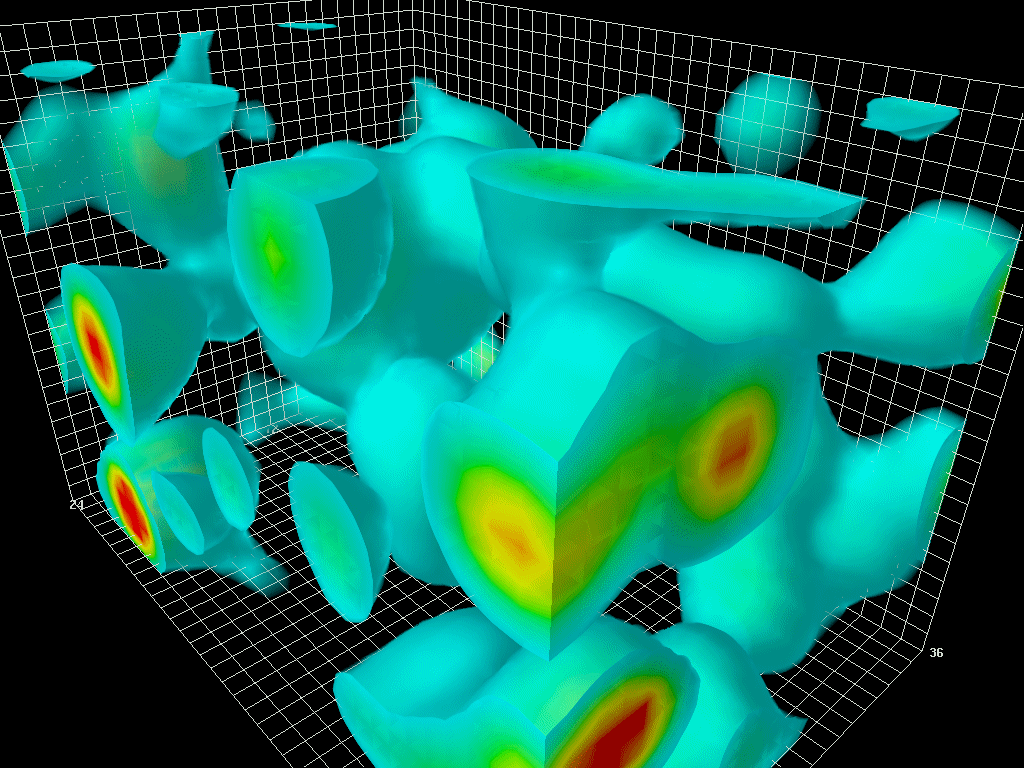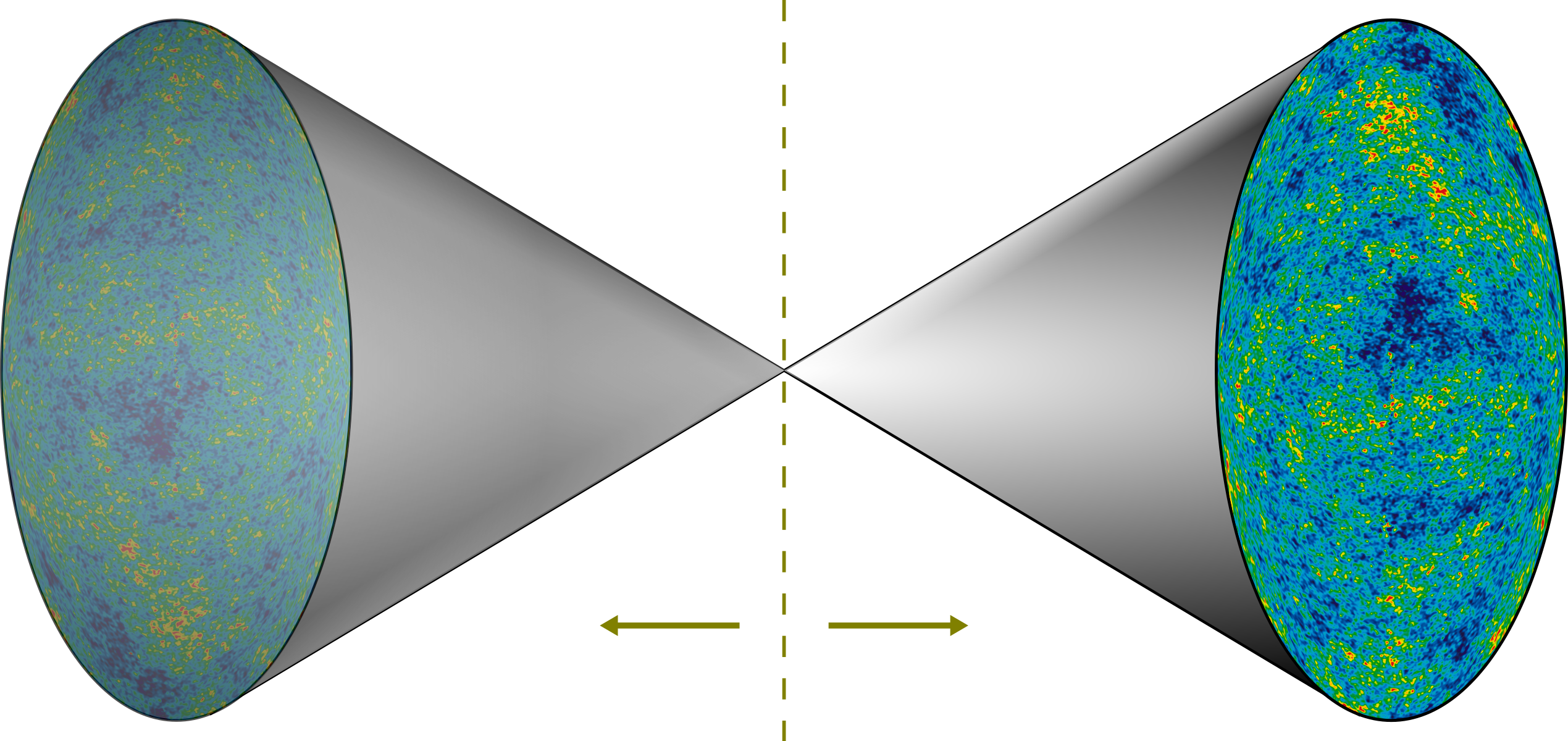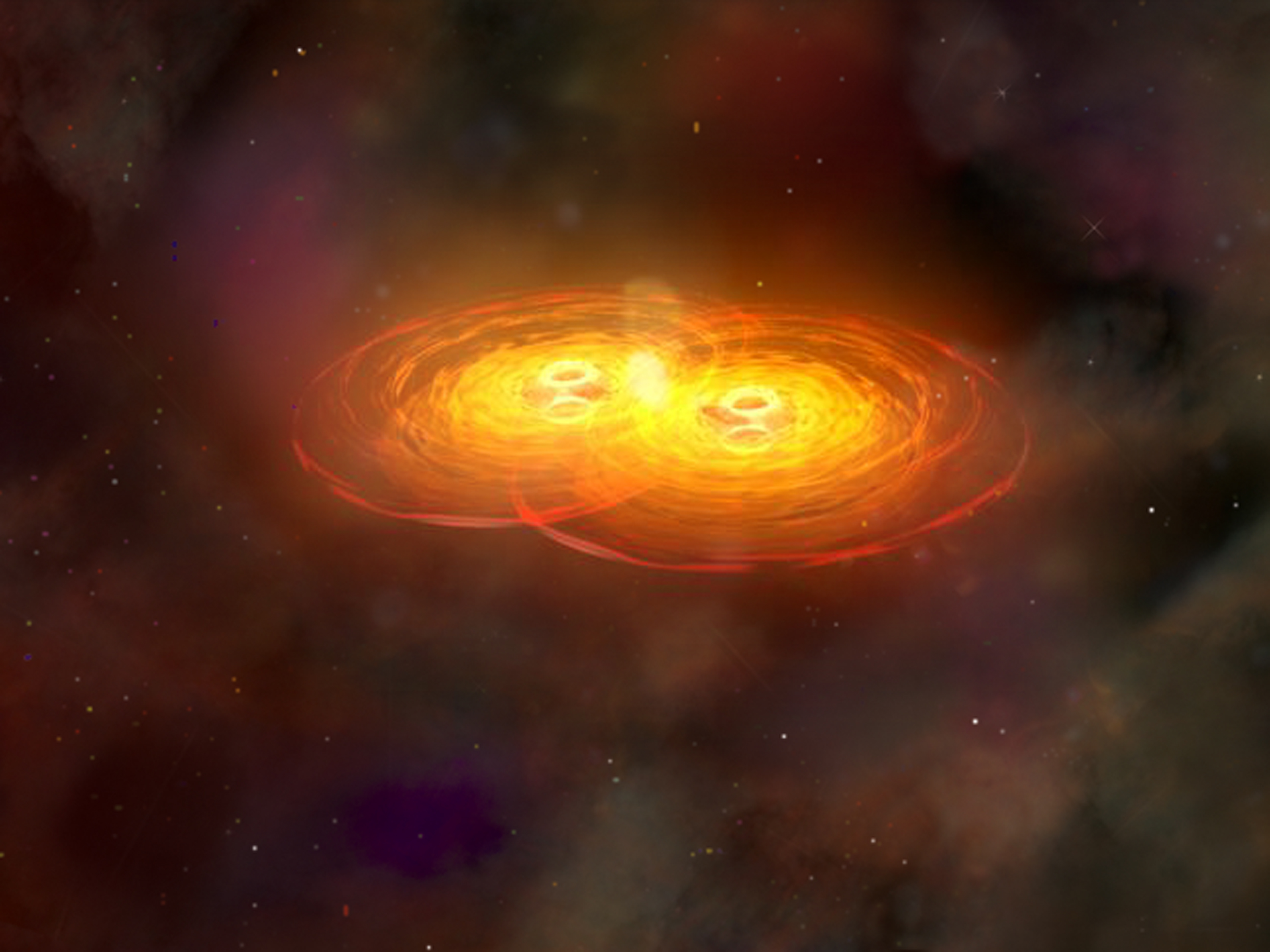|
Initial Singularity
The initial singularity is a singularity predicted by some models of the Big Bang theory to have existed before the Big Bang and thought to have contained all the energy and spacetime of the Universe. The instant immediately following the initial singularity is part of the Planck epoch, the earliest period of time in the history of our universe. Traditional models of our Universe The use of only general relativity to predict what happened in the beginnings of the Universe has been heavily criticized, as quantum mechanics becomes a significant factor in the high-energy environment of the earliest Universe, and general relativity on its own fails to make accurate predictions. In response to the inaccuracy of considering only general relativity, as in the traditional model of the Big Bang, alternative theoretical formulations for the beginning of the Universe have been proposed, including a string theory-based model in which two branes, enormous membranes much larger than the Univers ... [...More Info...] [...Related Items...] OR: [Wikipedia] [Google] [Baidu] |
Gravitational Singularity
A gravitational singularity, spacetime singularity or simply singularity is a condition in which gravitational field, gravity is so intense that spacetime itself breaks down catastrophically. As such, a singularity is by definition no longer part of the regular spacetime and cannot be determined by "where" or "when". Gravitational singularities exist at a junction between general relativity and quantum mechanics; therefore, the properties of the singularity cannot be described without an established theory of quantum gravity. Trying to find a complete and precise definition of singularities in the theory of general relativity, the current best theory of gravity, remains a difficult problem. A singularity in general relativity can be defined by the Curvature invariant (general relativity), scalar invariant Curvature of Riemannian manifolds, curvature becoming Infinity, infinite or, better, by a Geodesics in general relativity, geodesic being Geodesic manifold#Non-examples, incom ... [...More Info...] [...Related Items...] OR: [Wikipedia] [Google] [Baidu] |
Cosmic Microwave Background
In Big Bang cosmology the cosmic microwave background (CMB, CMBR) is electromagnetic radiation that is a remnant from an early stage of the universe, also known as "relic radiation". The CMB is faint cosmic background radiation filling all space. It is an important source of data on the early universe because it is the oldest electromagnetic radiation in the universe, dating to the epoch of recombination when the first atoms were formed. With a traditional optical telescope, the space between stars and galaxies (the background) is completely dark (see: Olbers' paradox). However, a sufficiently sensitive radio telescope shows a faint background brightness, or glow, almost uniform, that is not associated with any star, galaxy, or other object. This glow is strongest in the microwave region of the radio spectrum. The accidental discovery of the CMB in 1965 by American radio astronomers Arno Penzias and Robert Wilson was the culmination of work initiated in the 1940s, and earned th ... [...More Info...] [...Related Items...] OR: [Wikipedia] [Google] [Baidu] |
Quantum Fluctuation
In quantum physics, a quantum fluctuation (also known as a vacuum state fluctuation or vacuum fluctuation) is the temporary random change in the amount of energy in a point in space, as prescribed by Werner Heisenberg's uncertainty principle. They are minute random fluctuations in the values of the fields which represent elementary particles, such as electric and magnetic fields which represent the electromagnetic force carried by photons, W and Z fields which carry the weak force, and gluon fields which carry the strong force. Vacuum fluctuations appear as virtual particles, which are always created in particle-antiparticle pairs. Since they are created spontaneously without a source of energy, vacuum fluctuations and virtual particles are said to violate the conservation of energy. This is theoretically allowable because the particles annihilate each other within a time limit determined by the uncertainty principle so they are not directly observable. The uncertainty prin ... [...More Info...] [...Related Items...] OR: [Wikipedia] [Google] [Baidu] |
Multiverse
The multiverse is a hypothetical group of multiple universes. Together, these universes comprise everything that exists: the entirety of space, time, matter, energy, information, and the physical laws and constants that describe them. The different universes within the multiverse are called "parallel universes", "other universes", "alternate universes", or "many worlds". History of the concept According to some, the idea of infinite worlds was first suggested by the pre-Socratic Greek philosopher Anaximander in the sixth century BCE. However, there is debate as to whether he believed in multiple worlds, and if he did, whether those worlds were co-existent or successive. The first to whom we can definitively attribute the concept of innumerable worlds are the Ancient Greek Atomists, beginning with Leucippus and Democritus in the 5th century BCE, followed by Epicurus (341-270 BCE) and Lucretius (1st century BCE). In the third century BCE, the philosopher Chrysippus ... [...More Info...] [...Related Items...] OR: [Wikipedia] [Google] [Baidu] |
M-theory
M-theory is a theory in physics that unifies all consistent versions of superstring theory. Edward Witten first conjectured the existence of such a theory at a string theory conference at the University of Southern California in 1995. Witten's announcement initiated a flurry of research activity known as the second superstring revolution. Prior to Witten's announcement, string theorists had identified five versions of superstring theory. Although these theories initially appeared to be very different, work by many physicists showed that the theories were related in intricate and nontrivial ways. Physicists found that apparently distinct theories could be unified by mathematical transformations called S-duality and T-duality. Witten's conjecture was based in part on the existence of these dualities and in part on the relationship of the string theories to a field theory called eleven-dimensional supergravity. Although a complete formulation of M-theory is not known, such a formu ... [...More Info...] [...Related Items...] OR: [Wikipedia] [Google] [Baidu] |
Physical Constant
A physical constant, sometimes fundamental physical constant or universal constant, is a physical quantity that is generally believed to be both universal in nature and have constant value in time. It is contrasted with a mathematical constant, which has a fixed numerical value, but does not directly involve any physical measurement. There are many physical constants in science, some of the most widely recognized being the speed of light in a vacuum ''c'', the gravitational constant ''G'', the Planck constant ''h'', the electric constant ''ε''0, and the elementary charge ''e''. Physical constants can take many dimensional forms: the speed of light signifies a maximum speed for any object and its dimension is length divided by time; while the fine-structure constant ''α'', which characterizes the strength of the electromagnetic interaction, is dimensionless. The term ''fundamental physical constant'' is sometimes used to refer to universal-but-dimensioned physical constants su ... [...More Info...] [...Related Items...] OR: [Wikipedia] [Google] [Baidu] |
Cyclic Model
A cyclic model (or oscillating model) is any of several cosmological models in which the universe follows infinite, or indefinite, self-sustaining cycles. For example, the oscillating universe theory briefly considered by Albert Einstein in 1930 theorized a universe following an eternal series of oscillations, each beginning with a Big Bang and ending with a Big Crunch; in the interim, the universe would expand for a period of time before the gravitational attraction of matter causes it to collapse back in and undergo a bounce. Overview In the 1920s, theoretical physicists, most notably Albert Einstein, considered the possibility of a cyclic model for the universe as an (everlasting) alternative to the model of an expanding universe. However, work by Richard C. Tolman in 1934 showed that these early attempts failed because of the cyclic problem: according to the Second Law of Thermodynamics, entropy can only increase. This implies that successive cycles grow longer and larger ... [...More Info...] [...Related Items...] OR: [Wikipedia] [Google] [Baidu] |
Big Bounce
The Big Bounce is a hypothesized cosmological model for the origin of the known universe. It was originally suggested as a phase of the ''cyclic model'' or ''oscillatory universe'' interpretation of the Big Bang, where the first cosmological event was the result of the collapse of a previous universe. It receded from serious consideration in the early 1980s after inflation theory emerged as a solution to the horizon problem, which had arisen from advances in observations revealing the large-scale structure of the universe. In the early 2000s, inflation was found by some theorists to be problematic and unfalsifiable in that its various parameters could be adjusted to fit any observations, so that the properties of the observable universe are a matter of chance. Alternative pictures including a Big Bounce may provide a predictive and falsifiable possible solution to the horizon problem, and are under active investigation as of 2017. Expansion and contraction The concept of the B ... [...More Info...] [...Related Items...] OR: [Wikipedia] [Google] [Baidu] |
Loop Quantum Gravity
Loop quantum gravity (LQG) is a theory of quantum gravity, which aims to merge quantum mechanics and general relativity, incorporating matter of the Standard Model into the framework established for the pure quantum gravity case. It is an attempt to develop a quantum theory of gravity based directly on Einstein's geometric formulation rather than the treatment of gravity as a force. As a theory LQG postulates that the structure of Spacetime, space and time is composed of finite loops woven into an extremely fine fabric or network. These networks of loops are called spin networks. The evolution of a spin network, or spin foam, has a scale above the order of a Planck length, approximately 10−35 meters, and smaller scales are meaningless. Consequently, not just matter, but space itself, prefers an atomic hypothesis, atomic structure. The areas of research, which involves about 30 research groups worldwide, share the basic physical assumptions and the mathematical description of q ... [...More Info...] [...Related Items...] OR: [Wikipedia] [Google] [Baidu] |
Branes
In string theory and related theories such as supergravity theories, a brane is a physical object that generalizes the notion of a point particle to higher dimensions. Branes are dynamical objects which can propagate through spacetime according to the rules of quantum mechanics. They have mass and can have other attributes such as charge. Mathematically, branes can be represented within categories, and are studied in pure mathematics for insight into homological mirror symmetry and noncommutative geometry. ''p''-branes A point particle can be viewed as a brane of dimension zero, while a string can be viewed as a brane of dimension one. In addition to point particles and strings, it is possible to consider higher-dimensional branes. A ''p''-dimensional brane is generally called "''p''-brane". The term "''p''-brane" was coined by M. J. Duff ''et al.'' in 1988; "brane" comes from the word "membrane" which refers to a two-dimensional brane. A ''p''-brane sweeps out a (''p''+1) ... [...More Info...] [...Related Items...] OR: [Wikipedia] [Google] [Baidu] |
Big Bang Theory
The Big Bang event is a physical theory that describes how the universe expanded from an initial state of high density and temperature. Various cosmological models of the Big Bang explain the evolution of the observable universe from the earliest known periods through its subsequent large-scale form. These models offer a comprehensive explanation for a broad range of observed phenomena, including the abundance of light elements, the cosmic microwave background (CMB) radiation, and large-scale structure. The overall uniformity of the Universe, known as the flatness problem, is explained through cosmic inflation: a sudden and very rapid expansion of space during the earliest moments. However, physics currently lacks a widely accepted theory of quantum gravity that can successfully model the earliest conditions of the Big Bang. Crucially, these models are compatible with the Hubble–Lemaître law—the observation that the farther away a galaxy is, the faster it is moving ... [...More Info...] [...Related Items...] OR: [Wikipedia] [Google] [Baidu] |
String Theory
In physics, string theory is a theoretical framework in which the point-like particles of particle physics are replaced by one-dimensional objects called strings. String theory describes how these strings propagate through space and interact with each other. On distance scales larger than the string scale, a string looks just like an ordinary particle, with its mass, charge, and other properties determined by the vibrational state of the string. In string theory, one of the many vibrational states of the string corresponds to the graviton, a quantum mechanical particle that carries the gravitational force. Thus, string theory is a theory of quantum gravity. String theory is a broad and varied subject that attempts to address a number of deep questions of fundamental physics. String theory has contributed a number of advances to mathematical physics, which have been applied to a variety of problems in black hole physics, early universe cosmology, nuclear physics, and conde ... [...More Info...] [...Related Items...] OR: [Wikipedia] [Google] [Baidu] |





